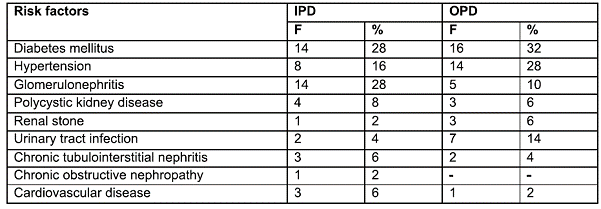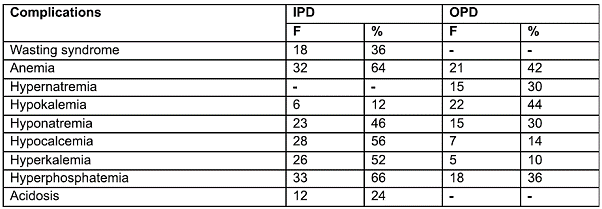ANALYSIS OF SPECTRUM OF CHRONIC KIDNEY DISEASE IN IPD AND OPD PATIENTS OF SELECTED HOSPITALS OF LUCKNOW CITY
*Research Scholar, Punjab Agriculture University. Punjab
**Guest Assistant Professor, Dept. of Food Sciences & Nutrition, CSA University of Agriculture & Technology
***Co-ordinator University Institute of Health Sciences, CSJM University Campus, Kanpur
E-mail — seemajaiswalgf@yahoo.com, Mo. No. 9369861198
ABSTRACT
The health care burden due to chronic kidney disease has increased worldwide in past decade. Elucidating the spectrum of chronic kidney may help in identifying strategies for prevention of chronic kidney disease. So the present study was conducted in 2 tertiary care centers of Lucknow to analyze the spectrum of chronic kidney disease in IPD and OPD renal pateints. 100 chronic kidney disease patients (50 from indoor patient department and 50 from outdoor patient department) of more than 15 years of age, belonging to different socioeconomic status were selected and surveyed. A questionnaire-cum-interview schedule method was used which included demographic profile of patients, risk factors, common symptoms, complications, severity of disease etc. The findings concluded diabetes as a most prevalent risk factor among patients of both groups, followed by hypertension and other glomerular diseases. Vomiting, edema, nausea and abdominal pain were common in both groups. Anemia was found as the most prevalent complication, followed by hyperphosphatemia and hyponatremia. Other diseases like diabetes mellitus, high blood pressure, infections, CVD and obesity cause greater levels of morbidity and mortality among the population as a whole and kidney disease is important in large part because of its relationship with more common diseases. Early treatment can reduce the risk of developing more serious disease or can at least slow the rate at which the disease progresses.
Keywords : chronic kidney, risk factors, spectrum of CKD, symptoms of CKD, complications of CKD.
INTRODUCTION
Kidneys play an essential role in the maintenance of normal homeostasis. A variety of diseases may affect the kidneys and lead to progressive nephron loss. Chronic kidney disease is defined as a progressive loss of renal function over a period of months or years through five stages. Each stage is a progression through an abnormally low and deteriorating glomerular filtration rate (National Kidney Foundation, 2002) (NKF KIDOQI). The term “spectrum” is the graphic representation of variations in the manifestations of chronic kidney disease (Park, 2007). It contains illnesses ranging in severity from mild to severe and risk factors which gradually lead further diseases. The sequence of events in the spectrum of disease can be interrupted by early diagnosis and treatment or by preventive measure which if introduced at a particular point will prevent or retard the further development of the disease. The spectrum shows variations in IPD and OPD. So the present study was conducted to analyze the spectrum of chronic kidney disease and associated risk factors in IPD and OPD renal patients.
MATERIALS AND METHODS
The study was conducted at in and out patient wards of two tertiary care centers of Lucknow. A sample of 100 chronic kidney disease patients (50 from IPD and 50 from OPD) undergoing treatment, were randomly selected. A detailed questionnaire was developed to elicit data on demographic profile, previous health and medical history, morbidity pattern and severity of disease. Severity of disease was observed by estimated glomerular filtration rate (GFR) and stages of kidney disease. Estimation of GFR was done by using Cockcroft-Gault Equation (Chronic Kidney Disease, 2006).
RESULTS AND DISCUSSION
Demographic profile
Table 1:Demographic profile of chronic kidney disease patients

Spectrum of disease
A perusal of table 2 revealed that diabetes mellitus was the most prevalent risk factor among both groups (28 per cent in IPD and 32 per cent in OPD). Hypertension was more pre-existing in IPD (28 per cent) as compared to OPD (16 per cent). Majority of patients (28 per cent) in IPD and only 10 per cent patients in OPD were suffering from glomerulonephritis. The pathogenesis of diabetes mellitus may be genetic or due to some metabolic error. Hypertension causes destruction of glomeruli and glomerular diseases are the results of infections. A study of Y. K. Gupta (2008) also reported that diabetes mellitus is the main cause of kidney disease in adults in 40-60 years of age group. Sahu (2007) stated that diabetes mellitus is the leading cause of chronic kidney disease and end stage renal disease in India. According to SGPGI (1995) report, glomerulonephritis, followed by diabetic nephropathy were the most common causes of renal failure. Among 50 patients of IPD studied, edema (40 per cent) and dyspnoea (40 per cent) were some common symptoms, followed by vomiting (38 percent) and oliguria (36 per cent) (Table 3). In OPD, majority of patients were suffering from abdominal pain (30 per cent), followed by vomiting (16 per cent). The reason of edema is improper function of kidney. It does not remove extra fluid, builds up in the body, resulting swelling in legs, ankles, extremities and other body parts. Dyspnoea refers the air hunger, which is due to extra fluid in the body. Abdominal pain may be due to infection of intestine, glomeruli and renal tubules.
Complications faced by chronic kidney disease patients were revealed in table 4. Maximum patients (32 per cent) in IPD and 21 per cent patients in OPD were anemic, followed by hyperphosphatemia (33 per cent in IPD and 18 per cent in OPD), hypocalcemia was more prevalent in IPD (56 per cent) than OPD (14 per cent) while hypokalemic patients were more in OPD (44 per cent) than IPD (12 per cent).Anemia is the most common complication due to less production of erythropoietin (EPO) and fewer RBCs count in the body.
Table 2: Risk factors of chronic kidney disease in the patients.
N=100 (50+50)

Table 3: Symptoms of chronic kidney disease in the patients at the time of onset.
N=100 (50+50)


A study of Weiner (2005) also showed that anemia a common complication of chronic kidney disease. Hyperphosphatemia occurs due to decreased renal excretion of phosphorus in renal insufficiency. Hypocalcemia occurs due to losses of vitamin D and vitamin D binding protein. Hyperkalemia and hypokalemia occur due to acid-base imbalance that affects the serum potassium, by altering renal potassium excretion.
Table 5 shows the severity of disease, based on estimated glomerular filtration rate (GFR). As the disease progresses, declination in GFR take place. Maximum patients (40 per cent) fell in stage 4 in IPD followed by stage 5 (40 per cent). No patient was seen in stage 1, while in OPD, majority of patients belonged to stage 2 (48 per cent) followed by stage 3 (32 per cent). No patient was found in stage 5. So OPD patients were in better condition than IPD patients. In IPD group, most of the patients required dialysis because of renal failure, while in OPD, kidney disease gradually progresses and through proper treatment, it can be prevented. So only few patients needed dialysis in OPD.
Table 4: Prevailing complications of chronic kidney disease in the patients.
N=100 (50+50)

Table 5: Severity of disease based on glomerular filtration rate.
N=100 (50+50)

SUMMARY AND CONCLUSION
A study was conducted to analyze the spectrum of chronic kidney disease in IPD and OPD. There was a trend towards more frequent pre-existing diabetes mellitus in both groups, followed by glomerular disease in IPD and hypertension in OPD. Edema, nausea, vomiting and abdominal pain were the common symptoms of chronic kidney disease patients, found in both groups at the time of onset of disease. Anemia was a common complication of chronic kidney disease, followed by hyperphosphatemia and hypocalcemia. The disease spectrum ascends from OPD to IPD as majority of IPD patients fell in stage 4 and stage 5, while in OPD, majority of patients belonged to stage 2 and stage 3. The condition of IPD patients was more severe than OPD patients.
REFERENCES:
Chronic Kidney Disease (2006). Ndt.oxfordjournals.org/cgi/reprint/2 1/supple- 4/390.
Gupta, Y. K. (2008). All India Institute of Medical Sciences (AIIMS), New Delhi, Feb 14.
National Kidney Foundation (2002). Kidney Disease Outcomes Quality Initiatives (NKF K/DOQI), Clinical practice guidelines. Executive Summaries, New York: The Foundation.
Park, K. (2007). Preventive and Social Medicine. 19 edi., Banarsidas Bhanot, Jabalpur.
Sahu, S. (2007). “The incidence of end-stage renal disease in India”. Department of Nephrology, PGI, Chandigarh, July 31.
SGPGI (1995). “Chronic Renal Failure in India”. Deptt. Of Nephrology, SGPGI Of Medical Sciences, U.P., India.
Weiner, D.E.; Tighiouart, H.; Vlagopoulos, P.1 (2005). “Effects of anemia and left ventricular hypertrophy on cardiovascular disease in patients with chronic kidney disease”. JAm Soc Nephrol .16:1803-1810.
Article Information
Sr No: 6
Page No: 29-33
Size:
Download:
Cited By:
Language: English
Licence: IJW
Authors: Tanu Jain *, Seema Jaiswal, Praveen Katiyar
Authors Address: Research Scholar, Punjab Agriculture University, Punjab
Email: E-mail : seemajaiswalgf@yahoo.com
Published: 14 November, 2014



